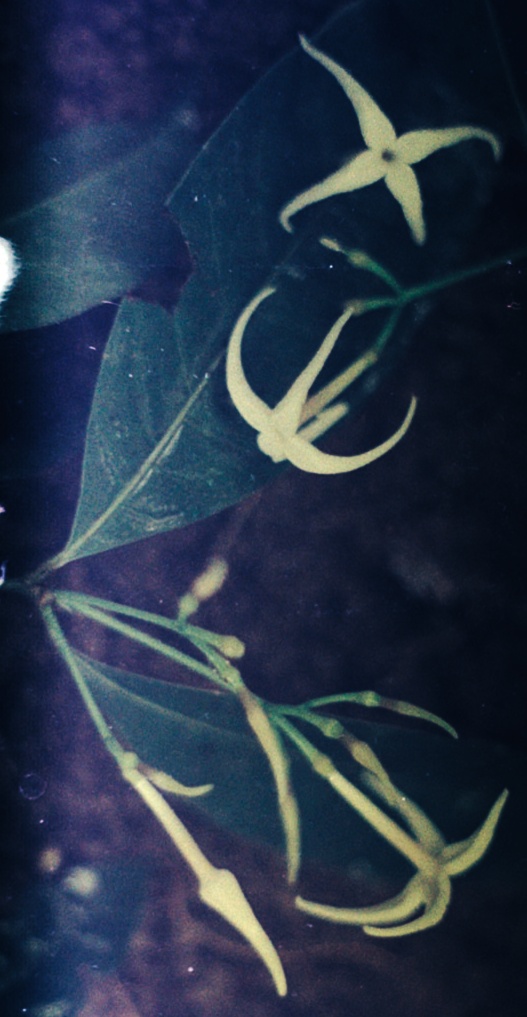Faramea occidentalis (L.) Rich.
Rubiaceae
HUESITO
Occasional evergreen understory tree (4-6 m) found amid primary forests on well-drained hillsides; it avoids wet, low-lying valleys and the dry, sandy coastline. Faramea generates large crops of food-providing fruits every two years, and it is important to the local ecology for this reason. These are preceded by an impressive display of spidery, aromatic, white flowers.
Description: Faramea is a tree of small stature, with a straight trunk that rarely exceeds 20 cm in diameter. The boles of the largest individuals tend to be textured by shallow folds and creases that may extend to the base of the tree, forming small buttresses. Faramea bark is mostly smooth, dull, and gray-green in color. Along its upper half, the bole gives rise to a small number of slight, mainly horizontal branches that together form a very thin, narrow crown. The simple, opposite leaves (16-21 cm by 5-7 cm) appear paired and are quite variable in size (ranging from 16-21 cm in length and 5-7 cm in width). Short shoots, bearing a single pair of smaller leaves, are frequently observed emerging from the axils of the large blades. All foliage has a characteristically elongated shape whose elliptical form is broken only by the presence of well-developed drip tips (1 cm). Blade surfaces are smooth and glossy, and they possess marked indentations where primary and secondary veins have been impressed into them. Petioles (1 cm) are flanked by tiny stipules at their point of attachment to the twig. Most new leaf and twig growth occur in May, and light-colored pairs of pale-green leaves can be seen expanding to full size at this time. During this process, individual trees may augment their pre-existing leaf cover by 20-30%.
Flowers develop in terminal panicles (8 cm) that are composed of a few, relatively large blossoms. They appear first as tubular and long-tapering green buds that protrude from thick, cup-shaped calyxes (resembling the long, straight claws of some animal). At the base of each bud, a peculiar, rounded swelling marks the location of the inferior flower ovary. When mature, the now snow-white blossoms (3 cm long by 4 cm in diameter) sport a long, tubular corolla that ends in four, backward-curving and slow-tapering, spidery petals. The front of the flower – where the petals diverge from the corolla tube – is formed by the convergence of wider and flatter regions possessed by each petal at this point. Buried deep inside the corolla, a single pistil is topped by a two-part, leafy stigma. In addition to their distinctively stringy aspect, Faramea flower petals are thick and spongy. When squeezed, they exude a perfumey liquid that is responsible for the strong, sweet, candy-like odor that these blossoms emit. Flowering periods are highly synchronized events, however they are not consistent in size nor scope from one season to the next. Indeed, in some years (e.g. 1990, 1993) very few blossoms are produced, while in others (1989, 1992, 1995) they are apparently ubiquitous. In any season, flowering is an ephemeral event confined to a brief, two week period in May.
Fruits are plain, spherical drupes (1.5 cm). Resembling large blueberries, the persistent calyxes form circular depressions, scaring them distally. During the ripening process, their color slowly changes from pale green through pink, finally becoming a deep purple-black. Each drupe consists of a thick, fleshy layer of juicy pulp surrounding a single, 0.8 cm stony pit. Ripe fruits are present over a much more extended period than the blossoms, with harvests lasting from late September though early December. Logically, harvest size is directly correlated to flowering intensity for any given season.
Similar Species: Eugenia acapulcensis, Posoqueria latifolia, and Chione sylvicola are trees of similar stature that share Faramea‘s habitat as well. The latter tree can be readily distinguished from them, however, by the relatively narrow shape of its leaves (the others possess broader, more rounded foliage).
Natural History: Faramea flowers are visited by long-mouthed insects (notably butterflies) and hummingbirds. Croat (1978) suggests that plants with white flowers whose long, narrow, tubular corollas tend to be shed in the morning are pollinated by nocturnal moths – and he includes both Faramea occidentalis and Alibertia edulis among such species. Fruits are eaten and seeds are dispersed by arboreal mammals, like white-faced monkeys.
Distribution: In Manuel Antonio National Park (MANP), Faramea is found in the drier primary forest understories of Punta Catedral and Puerto Escondido. In Costa Rica, this species is also known from the Osa Peninsula. It ranges from Mexico to Ecuador and Brazil and is present in the West Indies.




